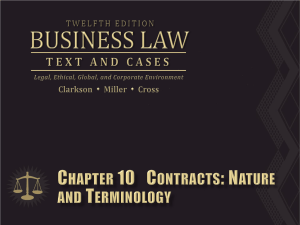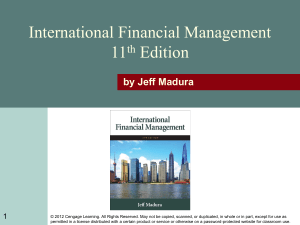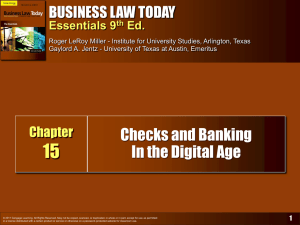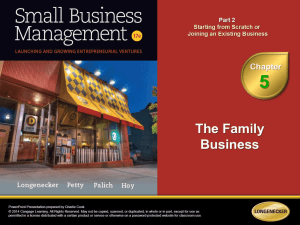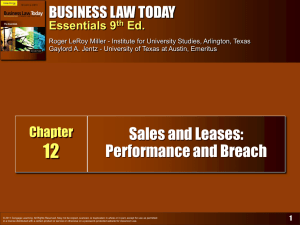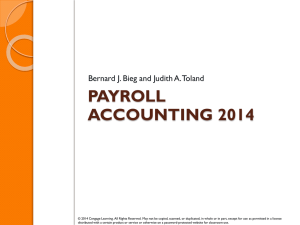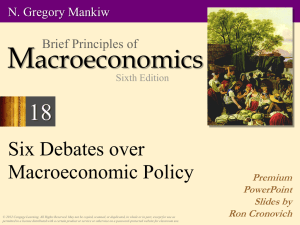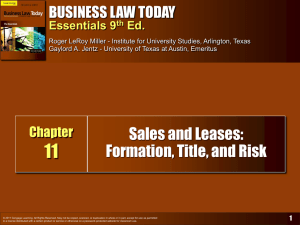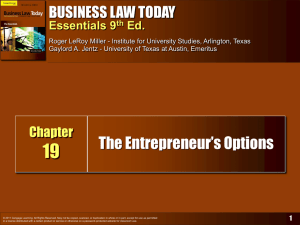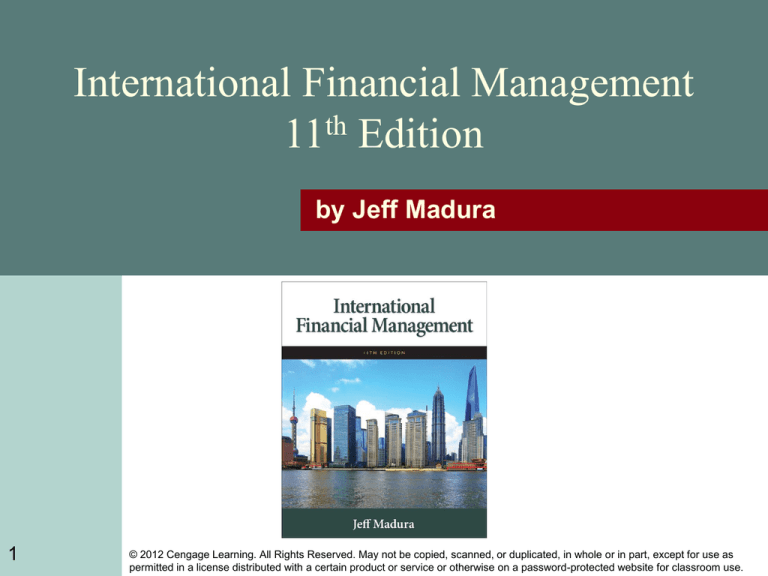
International Financial Management
11th Edition
by Jeff Madura
1
© 2012 Cengage Learning. All Rights Reserved. May not be copied, scanned, or duplicated, in whole or in part, except for use as
permitted in a license distributed with a certain product or service or otherwise on a password-protected website for classroom use.
Part 1
The International Financial Environment
2
© 2012 Cengage Learning. All Rights Reserved. May not be copied, scanned, or duplicated, in whole or in part, except for use as
permitted in a license distributed with a certain product or service or otherwise on a password-protected website for classroom use.
1Multinational Financial Management: An Overview
Chapter Objectives
3
Identify the management goal and organizational
structure of the Multinational Corporation (MNC).
Describe the key theories that justify international
business
Explain the common methods used to conduct
international business
Provide a model for valuing the MNC
© 2012 Cengage Learning. All Rights Reserved. May not be copied, scanned, or duplicated, in whole or in part, except for use as
permitted in a license distributed with a certain product or service or otherwise on a password-protected website for classroom use.
Managing the MNC
1. Managers are expected to make decisions that
will maximize the stock price.
2. Focus of this text: MNCs whose parents fully
own foreign subsidiaries (U.S. parent is sole
owner of subsidiary.)
3. Finance decisions are influenced by other
business discipline functions:
4
Marketing
Management
Accounting and information systems
© 2012 Cengage Learning. All Rights Reserved. May not be copied, scanned, or duplicated, in whole or in part, except for use as
permitted in a license distributed with a certain product or service or otherwise on a password-protected website for classroom use.
Agency Problems
The conflict of goals between managers and
shareholders
5
© 2012 Cengage Learning. All Rights Reserved. May not be copied, scanned, or duplicated, in whole or in part, except for use as
permitted in a license distributed with a certain product or service or otherwise on a password-protected website for classroom use.
Agency Costs
1. Definition: Cost of ensuring that managers
maximize shareholder wealth
2. Costs are normally higher for MNCs than for purely
domestic firms for several reasons:
6
Monitoring managers of distant subsidiaries in foreign
countries is more difficult.
Foreign subsidiary managers raised in different cultures
may not follow uniform goals.
Sheer size of larger MNCs can create large agency
problems.
Some non-U.S. managers tend to downplay the short-term
effects of decisions.
© 2012 Cengage Learning. All Rights Reserved. May not be copied, scanned, or duplicated, in whole or in part, except for use as
permitted in a license distributed with a certain product or service or otherwise on a password-protected website for classroom use.
Control of Agency Problems
1. Parent control of agency problems
Parent should clearly communicate the goals for each subsidiary
to ensure managers focus on maximizing the value of the
subsidiary.
2. Corporate control of agency problems
Entire management of the MNC must be focused on maximizing
shareholder wealth.
3. Sarbanes-Oxley Act (SOX)
Ensures a more transparent process for managers to report on the
productivity and financial condition of their firm.
7
© 2012 Cengage Learning. All Rights Reserved. May not be copied, scanned, or duplicated, in whole or in part, except for use as
permitted in a license distributed with a certain product or service or otherwise on a password-protected website for classroom use.
SOX Methods to Improve Reporting
Establishing a centralized database of information
Ensuring that all data are reported consistently
among subsidiaries
Implementing a system that automatically checks for
unusual discrepancies relative to norms
Speeding the process by which all departments and
subsidiaries have access to all the data they need
Making executives more accountable for financial
statements
8
© 2012 Cengage Learning. All Rights Reserved. May not be copied, scanned, or duplicated, in whole or in part, except for use as
permitted in a license distributed with a certain product or service or otherwise on a password-protected website for classroom use.
Management Structure of MNC
1. Centralized (See Exhibit 1.1a)
Allows managers of the parent to control
foreign subsidiaries and therefore reduce the
power of subsidiary managers
2. Decentralized (See Exhibit 1.1b)
Gives more control to subsidiary managers
who are closer to the subsidiary’s operation
and environment
9
© 2012 Cengage Learning. All Rights Reserved. May not be copied, scanned, or duplicated, in whole or in part, except for use as
permitted in a license distributed with a certain product or service or otherwise on a password-protected website for classroom use.
Exhibit 1.1a Management Styles of MNCs
10
© 2012 Cengage Learning. All Rights Reserved. May not be copied, scanned, or duplicated, in whole or in part, except for use as
permitted in a license distributed with a certain product or service or otherwise on a password-protected website for classroom use.
Exhibit 1.1b Management Styles of MNCs
11
© 2012 Cengage Learning. All Rights Reserved. May not be copied, scanned, or duplicated, in whole or in part, except for use as
permitted in a license distributed with a certain product or service or otherwise on a password-protected website for classroom use.
Why Firms Pursue International Business
1. Theory of Competitive Advantage: specialization
increases production efficiency.
2. Imperfect Markets Theory: factors of production are
somewhat immobile providing incentive to seek out
foreign opportunities.
3. Product Cycle Theory: as a firm matures, it
recognizes opportunities outside its domestic
market.
12
© 2012 Cengage Learning. All Rights Reserved. May not be copied, scanned, or duplicated, in whole or in part, except for use as
permitted in a license distributed with a certain product or service or otherwise on a password-protected website for classroom use.
Exhibit 1.2 International Product Life Cycles
13
© 2012 Cengage Learning. All Rights Reserved. May not be copied, scanned, or duplicated, in whole or in part, except for use as
permitted in a license distributed with a certain product or service or otherwise on a password-protected website for classroom use.
How Firms Engage in International Business
1.
2.
3.
4.
5.
6.
14
International trade
Licensing
Franchising
Joint Ventures
Acquisitions of existing operations
Establishing new foreign subsidiaries
© 2012 Cengage Learning. All Rights Reserved. May not be copied, scanned, or duplicated, in whole or in part, except for use as
permitted in a license distributed with a certain product or service or otherwise on a password-protected website for classroom use.
International Trade
15
Relatively conservative approach that can be used
by firms to
penetrate markets (by exporting)
obtain supplies at a low cost (by importing).
Minimal risk – no capital at risk
The internet facilitates international trade by
allowing firms to advertise their products and
accept orders on their websites.
© 2012 Cengage Learning. All Rights Reserved. May not be copied, scanned, or duplicated, in whole or in part, except for use as
permitted in a license distributed with a certain product or service or otherwise on a password-protected website for classroom use.
Licensing
16
Obligates a firm to provide its technology
(copyrights, patents, trademarks, or trade names)
in exchange for fees or some other specified
benefits.
Allows firms to use their technology in foreign
markets without a major investment and without
transportation costs that result from exporting
Major disadvantage: difficult to ensure quality
control in foreign production process
© 2012 Cengage Learning. All Rights Reserved. May not be copied, scanned, or duplicated, in whole or in part, except for use as
permitted in a license distributed with a certain product or service or otherwise on a password-protected website for classroom use.
Franchising
17
Obligates firm to provide a specialized sales or
service strategy, support assistance, and possibly
an initial investment in the franchise in exchange
for periodic fees.
Allows penetration into foreign markets without a
major investment in foreign countries.
© 2012 Cengage Learning. All Rights Reserved. May not be copied, scanned, or duplicated, in whole or in part, except for use as
permitted in a license distributed with a certain product or service or otherwise on a password-protected website for classroom use.
Joint Ventures
18
A venture that is jointly owned and operated by
two or more firms. A firm may enter the foreign
market by engaging in a joint venture with firms
that reside in those markets.
Allows two firms to apply their respective
cooperative advantages in a given project.
© 2012 Cengage Learning. All Rights Reserved. May not be copied, scanned, or duplicated, in whole or in part, except for use as
permitted in a license distributed with a certain product or service or otherwise on a password-protected website for classroom use.
Acquisitions of Existing Operations
19
Acquisitions of firms in foreign countries allows
firms to have full control over their foreign
businesses and to quickly obtain a large portion of
foreign market share.
Subject to the risk of large losses because of larger
investment.
Liquidation may be difficult if the foreign
subsidiary performs poorly.
© 2012 Cengage Learning. All Rights Reserved. May not be copied, scanned, or duplicated, in whole or in part, except for use as
permitted in a license distributed with a certain product or service or otherwise on a password-protected website for classroom use.
Establishing New Foreign Subsidiaries
20
Firms can penetrate markets by establishing new
operations in foreign countries.
Requires a large investment
Acquiring new as opposed to buying existing
allows operations to be tailored exactly to the
firms needs.
May require smaller investment than buying
existing firm.
© 2012 Cengage Learning. All Rights Reserved. May not be copied, scanned, or duplicated, in whole or in part, except for use as
permitted in a license distributed with a certain product or service or otherwise on a password-protected website for classroom use.
Summary of Methods
21
Any method of increasing international business
that requires a direct investment in foreign
operations is referred to as direct foreign
investment (DFI)
International trade and licensing usually not
included
Foreign acquisition and establishment of new
foreign subsidiaries represent the largest portion of
DFI.
© 2012 Cengage Learning. All Rights Reserved. May not be copied, scanned, or duplicated, in whole or in part, except for use as
permitted in a license distributed with a certain product or service or otherwise on a password-protected website for classroom use.
Exhibit 1.3 Cash Flow Diagrams for MNCs
22
© 2012 Cengage Learning. All Rights Reserved. May not be copied, scanned, or duplicated, in whole or in part, except for use as
permitted in a license distributed with a certain product or service or otherwise on a password-protected website for classroom use.
Exhibit 1.3 Cash Flow Diagrams for MNCs
23
The first diagram reflects an MNC that engages in
international trade. International cash flows result from
paying for imports or receiving cash flow from exports.
The second diagram reflects an MNC that engages in some
international arrangements. Outflows include expenses
such as expenses incurred from transferring technology or
funding partial investment in a franchise or joint venture.
Inflows are receipts from fees.
The third diagram reflects an MNC that engages in direct
foreign investment. Cash flows exist between the parent
company and the foreign subsidiary.
© 2012 Cengage Learning. All Rights Reserved. May not be copied, scanned, or duplicated, in whole or in part, except for use as
permitted in a license distributed with a certain product or service or otherwise on a password-protected website for classroom use.
Valuation Model for an MNC:
Domestic Model
E CF$,t
V
t
t 1 1 k
n
Where
V represents present value of expected cash flows
E(CF$,t) represents expected cash flows to be received at the
end of period t,
n represents the number of periods into the future in which
cash flows are received, and
k represents the required rate of return by investors.
24
© 2012 Cengage Learning. All Rights Reserved. May not be copied, scanned, or duplicated, in whole or in part, except for use as
permitted in a license distributed with a certain product or service or otherwise on a password-protected website for classroom use.
Valuation Model for an MNC:
Multinational Model
E CF$,t E CF j ,t E S j ,t
m
j 1
Where
CFj,t represents the amount of cash flow denominated in a
particular foreign currency j at the end of period t,
25
Sj,t represents the exchange rate at which the foreign currency
(measured in dollars per unit of the foreign currency) can be
converted to dollars at the end of period t.
© 2012 Cengage Learning. All Rights Reserved. May not be copied, scanned, or duplicated, in whole or in part, except for use as
permitted in a license distributed with a certain product or service or otherwise on a password-protected website for classroom use.
Valuation Model for an MNC
An MNC that uses two or more currencies
E CF$,t E CF j ,t E S j ,t
m
j 1
26
Derive an expected dollar cash flow value for each currency
Combine the cash flows among currencies within a given
period
© 2012 Cengage Learning. All Rights Reserved. May not be copied, scanned, or duplicated, in whole or in part, except for use as
permitted in a license distributed with a certain product or service or otherwise on a password-protected website for classroom use.
Uncertainty Surrounding MNC Cash Flows
1. Exposure to international economic conditions – If
economic conditions in a foreign country weaken, purchase
of products decline and MNC sales in that country may be
lower than expected.
2. Exposure to international political risk – A foreign
government may increase taxes or impose barriers on the
MNC’s subsidiary.
3. Exposure to exchange rate risk – If foreign currencies
related to the MNC subsidiary weaken against the U.S.
dollar, the MNC will receive a lower amount of dollar cash
flows than was expected.
27
© 2012 Cengage Learning. All Rights Reserved. May not be copied, scanned, or duplicated, in whole or in part, except for use as
permitted in a license distributed with a certain product or service or otherwise on a password-protected website for classroom use.
How Uncertainty Affects the MNC’s cost of Capital
A higher level of uncertainty increases the return on
investment required by investors and the MNC’s
valuation decreases.
28
© 2012 Cengage Learning. All Rights Reserved. May not be copied, scanned, or duplicated, in whole or in part, except for use as
permitted in a license distributed with a certain product or service or otherwise on a password-protected website for classroom use.
Exhibit 1.4 How an MNC’s Valuation is Exposed to
Uncertainty
29
© 2012 Cengage Learning. All Rights Reserved. May not be copied, scanned, or duplicated, in whole or in part, except for use as
permitted in a license distributed with a certain product or service or otherwise on a password-protected website for classroom use.
Exhibit 1.5 Organization of Chapters
30
© 2012 Cengage Learning. All Rights Reserved. May not be copied, scanned, or duplicated, in whole or in part, except for use as
permitted in a license distributed with a certain product or service or otherwise on a password-protected website for classroom use.
Summary
31
The main goal of an MNC is to maximize shareholder
wealth. When managers are tempted to serve their own
interests instead of those of shareholders, an agency
problem exists. MNCs tend to experience greater agency
problems than do domestic firms. Proper incentives and
communication from the parent may help to ensure that
subsidiary managers focus on serving the overall MNC.
© 2012 Cengage Learning. All Rights Reserved. May not be copied, scanned, or duplicated, in whole or in part, except for use as
permitted in a license distributed with a certain product or service or otherwise on a password-protected website for classroom use.
Summary
International business is justified by three key theories.
1. The theory of comparative advantage suggests that each
country should use its comparative advantage to
specialize in its production and rely on other countries to
meet other needs.
2. The imperfect markets theory suggests that because of
imperfect markets, factors of production are immobile,
which encourages countries to specialize based on the
resources they have.
3. The product cycle theory suggests that after firms are
established in their home countries, they commonly
expand their product specialization in foreign countries.
32
© 2012 Cengage Learning. All Rights Reserved. May not be copied, scanned, or duplicated, in whole or in part, except for use as
permitted in a license distributed with a certain product or service or otherwise on a password-protected website for classroom use.
Summary
33
The most common methods by which firms conduct
international business are international trade, licensing,
franchising, joint ventures, acquisitions of foreign firms, and
formation of foreign subsidiaries. Methods such as licensing
and franchising involve little capital investment but
distribute some of the profits to other parties. The
acquisition of foreign firms and formation of foreign
subsidiaries require substantial capital investments but offer
the potential for large returns.
© 2012 Cengage Learning. All Rights Reserved. May not be copied, scanned, or duplicated, in whole or in part, except for use as
permitted in a license distributed with a certain product or service or otherwise on a password-protected website for classroom use.
Summary
34
The valuation model of an MNC shows that the MNC’s
value is favorably affected when its expected foreign cash
inflows increase, the currencies denominating those cash
inflows increase, or the MNC’s required rate of return
decreases. Conversely, the MNC’s value is adversely
affected when its expected foreign cash inflows decrease,
the values of currencies denominating those cash flows
decrease (assuming that they have net cash inflows in
foreign currencies), or the MNC’s required rate of return
increases.
© 2012 Cengage Learning. All Rights Reserved. May not be copied, scanned, or duplicated, in whole or in part, except for use as
permitted in a license distributed with a certain product or service or otherwise on a password-protected website for classroom use.

